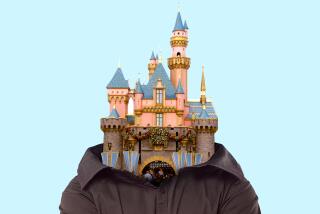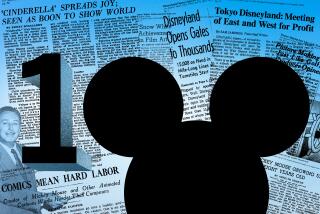Opinion: No-fly zones over Disney have cynical Mickey-haters smelling a rat
- Share via
Somewhere in Washington, there are committees of bureaucrats assigned to assess which American icons are most likely to be attacked by terrorists. At the Federal Aviation Administration, there is such a task force that looks at national landmarks to guess which ones wannabe evildoers are most likely to attack from the air, whether it comes in the form of a 9/11-style airplane-as-bomb or something else.
“National defense airspaces” are officially designated “no fly” zones. Yes, as in Iraq under Saddam Hussein. Pilots won’t get shot down for crossing over them. But they might be intercepted by Air Force fighter jets and grilled by Very Angry Fed People. Violators are subject to a hefty $10,000 fine and a year in the pokey. It’s serious business.
Anyway, it turns out that among America’s special terror-proof, no-fly places is the air over the houses Walt built: Disneyland in Anaheim and Disney World in Orlando.
What happens if you cruise over Disneyland Paris? Will clusters of Mirage 2000s converge on you? I’m waiting to hear back on this.
The Times’ Matt Pearce reports: “The Disney restrictions have been in place since 2003, thanks to a provision quietly slipped into a massive congressional spending bill weeks before the Iraq war. Defense and counter-terrorism officials did not appear to ask for the Disney protections, which were instead urged by at least one Disney lobbyist, according to an Orlando Sentinel investigation in 2003.”
Cynical Mickey-haters smell a rat, according to Pearce:
“The restrictions effectively ended a war between Disney and aerial advertisers who had buzzed over the parks for years before the Sept. 11, 2001, terrorist attacks.”
“ ‘Banner towers used to make money with their banner tows around Disneyland; now they’re not allowed to. ... People can’t take aerial photography shots,’” Mark Skinner, owner of Anaheim Helicopters, told Pearce. “But ‘you can fly [around] Knott’s Berry Farm, Six Flags, no big deal,’ he said.”
So that worked out for Disney.
It is possible that, if the leaders of the head-lobbing terror monsters of Islamic State want to hit America where it hurts, and if they somehow get a plane, and if they want fly that plane into an amusement park (or drop Ebola bombs from it, or whatever), that Disney might be more likely to come to mind than, say, Universal Studios — which, at this writing, remains a free-fly zone.
Maybe.
It is also true that is awfully hard, especially for midlevel management types who live in the DC burbs, to divine terrorist intent. Many New Yorkers remain mystified that Al Qaeda went after the World Trade Center not once, but twice. The Twin Towers were second-rate real estate, full of back offices — which is why not a single bold-face “captain of the universe” was among the list of victims on the ground. Why not the Empire State Building? Wall Street? Midtown? (The likely reasons: the Twin Towers, on the Hudson River, were easy for barely trained hijackers to hit, and the plotters mistakenly thought the buildings were symbols of American financial power.)
The obvious silliness aside, serious 1st Amendment issues are affected by the FAA designation of Disney as the Happiest Dangerous Place on Earth.
According to The Times article, “A Christian group, the Family Policy Network, sued the government in 2003 to allow a pilot to fly a banner that read ‘Jesus Christ: Hopeforhomosexuals.com’ over Walt Disney World during Gay Day. In its court filing, the group argued that the no-fly zone was unfair because Disney didn’t own the airspace and that other theme parks or potential terrorism targets, such as downtown Chicago, didn’t have similar zones…. A federal judge threw out the Family Policy Network’s arguments, writing that combating terrorism required ‘unquestioning adherence’ to Congress’ action.”
“Unquestioning adherence”? The terrorists have definitely won.
Follow Ted Rall on Twitter @tedrall
More to Read
A cure for the common opinion
Get thought-provoking perspectives with our weekly newsletter.
You may occasionally receive promotional content from the Los Angeles Times.









